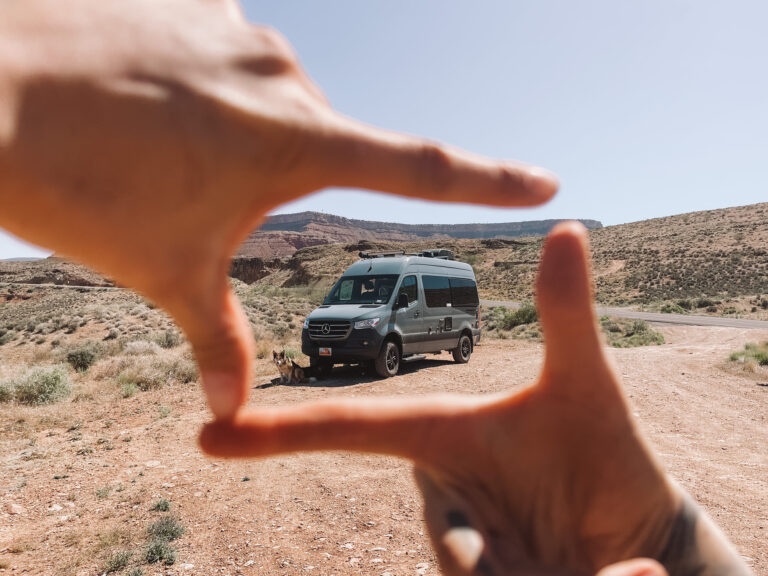
RV travel is an unforgettable and relatively inexpensive way to see the country. It gives you the opportunity to wander off the beaten path, stay in the moment, and stay comfortable as you do so.
But the world of RVing can be overwhelming for those who are just jumping in. Driving a motorhome can feel absolutely terrifying when doing it for the first time, and setting up camp can be stressful if you have no idea what you’re doing.
There are all kinds of things to learn before your first RV trip. Fortunately, we’re here for you. Below is a compilation of the most important RV basics for beginners. As long as you know these basic tips for RV operation, you’ll be able to hit the road with confidence. So, let’s dive into RV Basics 101!
Choosing the Right RV
The very first thing you need to learn about? The types of RVs out there. After all, you can’t very well know which kind of RV you’d like without knowing what your options are.
The first question to ask yourself is whether you prefer a driveable RV or if you’d rather have a towable. Of course, if you want a towable, you will need to make sure you have a truck capable of pulling it safely. Because trucks are expensive and many people don’t want a truck they only use for camping, a driveable RV is the best option for many. This is especially true if you plan on renting the RV and taking it to your destination yourself.
Drivable RV Types
First, let’s take a look at the different types of drivable RVs out there. This will help you further narrow down your options so you know just what you’re looking for when you start shopping for an RV to rent or buy.
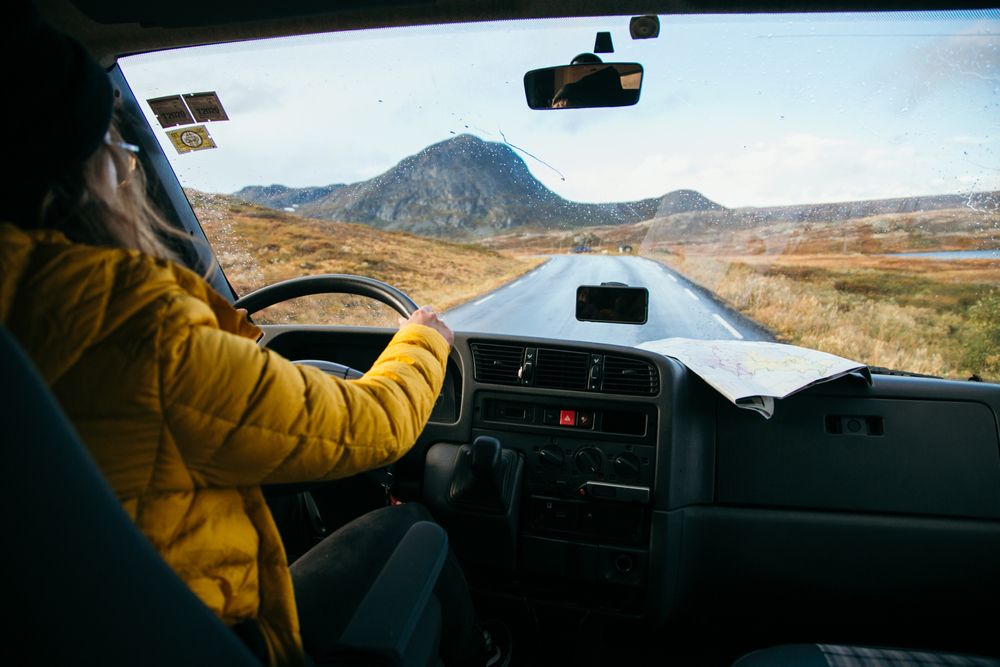
Class A RV
Generally speaking, class As are the biggest of the drivable RVs (though there are some smaller models out there). These are the motorhomes that look like buses and are often referred to as coaches. They tend to offer the most living space but also have the biggest learning curve when it comes to driving them. These are a great choice for large families or full-time living.
Class C RV
The class C RV is what many people think of when they think “motorhome.” This is the rig that looks a lot like a moving van. They are built on a van chassis and have a piece that juts out over the cab to make space for a bed, or sometimes an entertainment center. Class C RVs drive a lot like a van, making them relatively easy to drive, but they also tend to be smaller than class A RVs. These are a good pick for small families or groups of friends.
Class B RV or Campervan
Finally, there is the class B RV, or campervan. This is a much smaller rig, typically built into a cargo van. They typically don’t have slides and there isn’t much room for many amenities or extras. Instead, they provide just the basics in an easy-to-drive vehicle with the benefit of being able to adventure off the grid pretty much anywhere. Class Bs are perfect for solo travelers or couples.
The Benefits of Small Drivable RVs vs the Benefits of Large Drivable RVs
Still not sure which option is right for you? Not to worry, we have more things for you to consider.
Another way to narrow things down is to decide how big you’d like your rig to be. That said, it’s pretty hard to know the answer to this without understanding what the pros and cons of each are. For this reason, we’re using this section to explain the benefits of both smaller RVs and larger RVs.
Benefits of Small Drivable RVs
Let’s start by listing our favorite benefits of camping in a small motorhome. If these benefits appeal to you, a small class C or campervan might be the best pick for you.
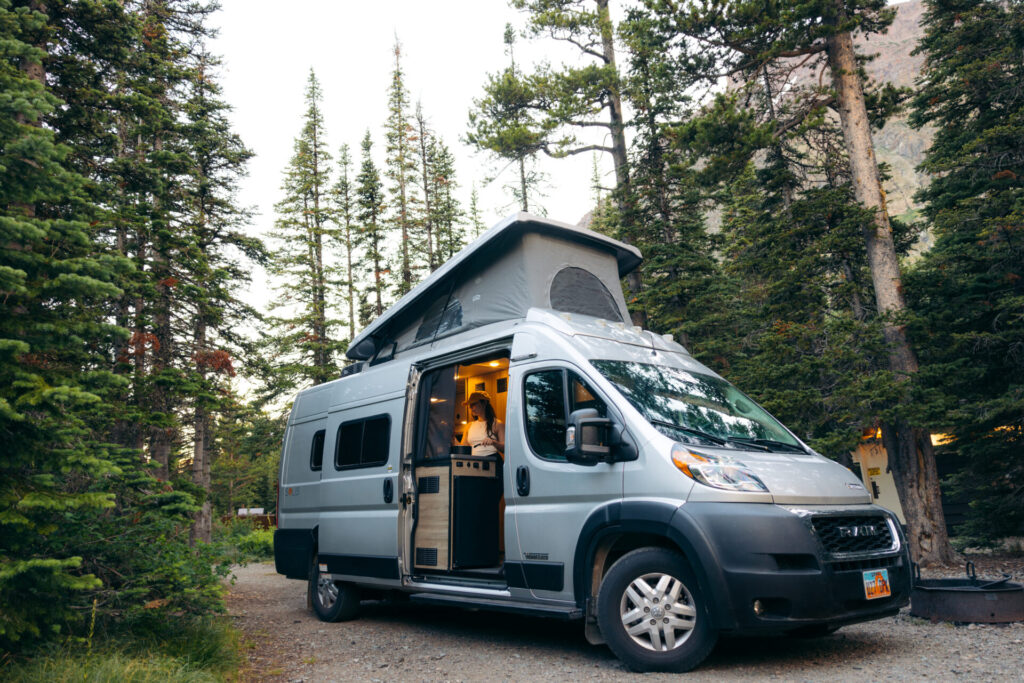
Easier to Drive
As mentioned before, class B and smaller class C RVs are easier to drive than the bigger rigs out there. They are built on van chassis, meaning they drive very much like a van—and of course, the smaller the rig is, the easier it is to maneuver.
More Parking Available
Finding parking for an enormous rig can be a pain in the neck. Some parking lots simply will not be able to accommodate you, and squeezing into others will be dangerous and tedious. Smaller RVs, on the other hand, can park pretty much anywhere, and the smaller your motorhome is, the more parking options you’ll have.
Good for Off-Road Driving
Another thing small RVs can do more easily? Drive off-road. If you plan to do a lot of boondocking on undeveloped land, this can be a major bonus, so be sure to keep camping locations in mind when choosing the size of your RV.
Benefits of Large Drivable RVs
What about a bigger motorhome? Well, there are several benefits to having a larger home-on-wheels as well. If the pros listed below sound like something you’d enjoy, go for a class A or at least a larger class C.
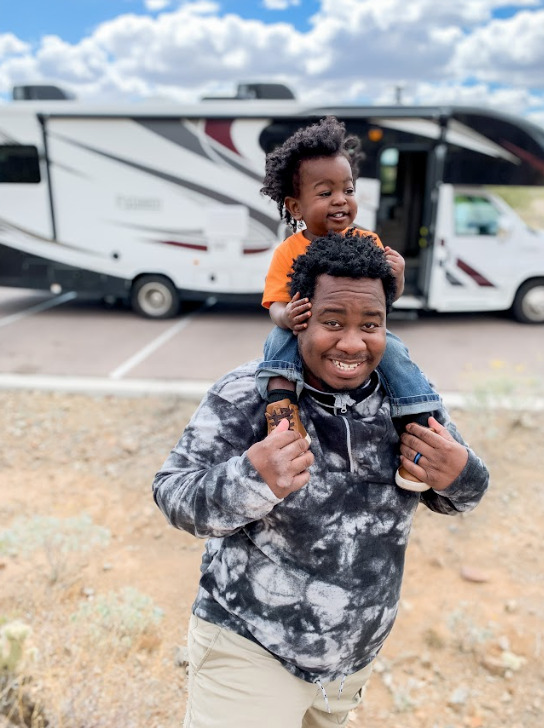
More Storage Space
Generally speaking, the bigger your RV is, the more storage space you’re going to have. Therefore, if you plan to go on adventures with a lot of people or you want to be on the road for long periods of time, a larger motorhome with more storage bays might be your best bet.
Extra Amenities
Another thing that fits better in a bigger motorhome? More amenities. If you’re looking to have plenty of seating options, a bathtub, a large sink, and an oven, you’ll almost certainly be better off in a class C or class A rather than a campervan.
Room to Spread Out
If you’ll be spending lots of time in your RV, you’ll probably get tired of being in close quarters with family pretty quickly. For this reason, you’ll likely want to look into a larger motorhome that allows everyone to spread out and have their own space. This is especially nice when the weather isn’t great and everyone finds themselves stuck indoors.
Other Things to Look For in a Drivable RV
So far, we’ve discussed the types of drivable RVs, as well as the pros and cons of large RVs versus their smaller counterparts. This information has probably given you a decent idea of what you’re looking for, but there are more things to consider.
These include:
Floor Plan
Be sure to consider the way the interior of the RV is set up. Think about day-to-day life in the RV, where everyone will sleep and sit, and how your family will fit into each floor plan you consider.
Storage Space
Because RVs are such small living spaces, storage space is very valuable. Keep storage in mind when RV shopping and make sure any RV you buy has enough space for everything you need to take along on an RV trip.
Amenities
If you have specific amenities in mind, make a list of those so you don’t accidentally miss any. Some popular amenities include a bathtub, an RV prepped for solar, lithium batteries, heated seating, and fold-away furniture.
Holding Tank Sizes
If you plan on boondocking, the size of your holding tanks becomes very important. Make sure you look into the size of the tanks on any RV you buy. The bigger tanks you can find, the better off you’ll be, but keep in mind the fact that vans and other small rigs will almost certainly have smaller tanks.
Fuel Type
In the case of drivable RVs, you’ll also want to consider fuel type. Diesel RVs tend to be stronger and do better on mountains. That said, regular gas is almost always cheaper and is easier to find anywhere. Additionally, the repairs on a diesel vehicle tend to be more expensive.
Gas Mileage
If you plan on traveling long distances, gas mileage can be another important factor to consider. As you might have guessed, smaller RVs almost always get better gas mileage, but this isn’t the only factor, so be sure to look at this before purchasing.
Cargo Carrying Capacity
Your cargo carrying capacity (CCC) is how much you can safely carry. Class A RVs have much higher CCCs than class Cs or class Bs, making them the best bet if you need to carry a lot of people and/or stuff. The CCC on a class C can be very limited, so keep that in mind as you shop.
Tow Rating
You’ll also want to look at the tow rating of each drivable RV you consider. If you plan to tow a small car around, this number is very important, as it tells you how much weight your RV can safely tow, letting you know what kind of car you might be able to have.
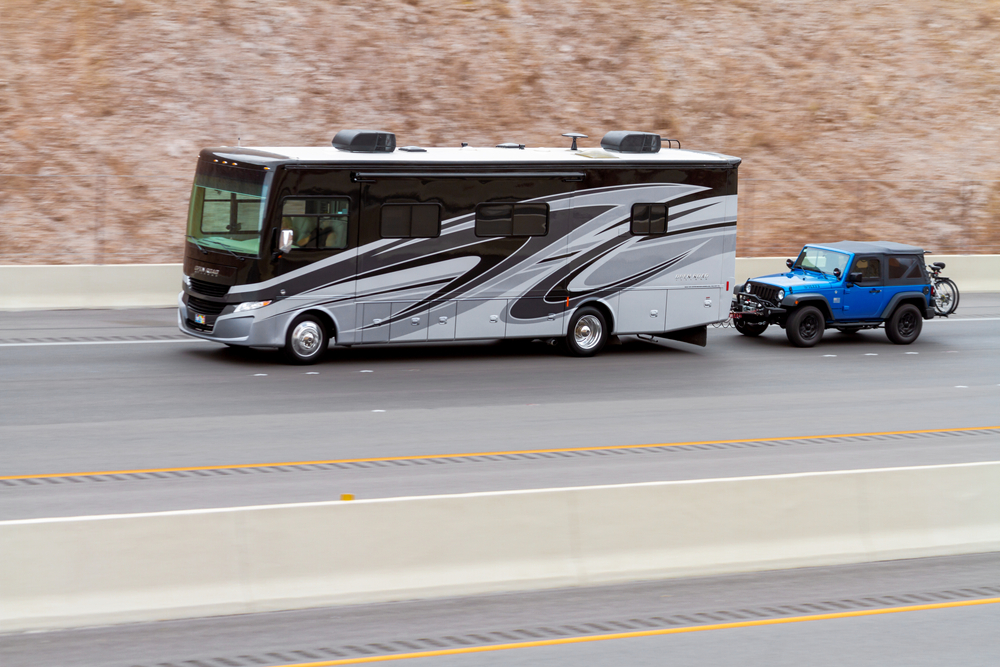
Operating Your RV: The Tools You Need
Once you’ve decided on the type of RV you’re going to purchase or rent, you’re ready to hit the road… right? Well, not exactly. Before you even begin RV operation, you will need to pack the rig with some essential tools. Many beginner RVers have no idea what kinds of tools they might need in order to navigate safely in an RV and then set up camp once they arrive at their destination.
For these individuals, we’ve compiled the lists below. Gather these things and you’ll be well-equipped for your first RV adventure.
For Traveling with the RV
These are must-have items for the travel day portion of RV operation. They will ensure you’re safe along the way and that you always know where you’re going, no matter where you may wander:
- RV GPS
- Road Atlas
- RV-rated jacks
- Spare tire
- Jumper cables
- RV roadside assistance (Good Sam or Coach-Net)
For Camping in the RV
Once you arrive at camp, these are the items you’ll want to have on hand in order to get set up and ready to enjoy your stay:
- Basic tool kit
- Leveling blocks
- Bubble level
- Jack pads
- Sewer hose
- Freshwater hose
- Water pressure regulator
- Surge protector
How to Avoid Mistakes and Accidents
One of the biggest fears people have when operating an RV for the first time is that they’ll make a huge mistake and mess up the rig. This is understandable. After all, RVs aren’t cheap. That said, as long as you know some basic tips and tricks like we’ve listed below, you shouldn’t have any huge problems.
Adjust Your Mirrors
As soon as you hop in the driver’s seat of your motorhome, check the mirrors. Chances are they won’t be where they need to be, and since it can be so hard to see behind you in an RV, your mirrors are a super important tool. For this reason, you will want to adjust your mirrors right away.
Use an RV-Specific GPS
We highly recommend using an RV-specific GPS or GPS app like RVlife. Using a GPS made specifically for RVers will help you avoid routes that big rigs can’t handle. The perk of a GPS unit is that it allows you to download routes to ensure you have accurate directions even if no cell connection is available, and some even provide extra features such as a campground search.
Have a Navigator
In addition to using an RV-specific GPS, we also recommend having a passenger close by to help with navigation. This person can help decipher the GPS instructions if they happen to be unclear. They can also navigate you using the aforementioned trucker’s road atlas should the GPS be out of service for any reason.
Avoid Steep Grades
The RV GPS should help you with this one. That said, you might want to double-check every route against the trucker’s atlas just to be sure you can handle any steep grades you might come across. Generally speaking, we like to stick to roads with a 6% grade or less, especially if the incline lasts for miles (and especially if we’re in a large RV).
Take It Slow
If you’re driving an RV, chances are you’re on vacation. This means there’s no real reason to rush and every reason to take things slow. Slowing yourself down, leaving plenty of space between yourself and other vehicles, and hanging out in the right-hand lane whenever possible will make your travel a lot less stressful and a lot safer.
Pick a speed around 55 or 60 mph and stick to it. Other people will go around you, but that’s okay. It’s better to take things a bit more slowly and stay safe than it is to get there a little bit faster.
Leave Space, Brake Early
Keep in mind that your rig is much heavier than a typical car, and has a LOT more momentum pushing it forward, so it’s going to take longer to stop. For this reason, it is extremely important that you leave a nice, big cushion of space between you and the car in front of you. Not only that, you will want to pay careful attention so you can begin braking earlier than you normally would. This will help you avoid rear-ending other vehicles, keeping you and those around you safe.
Make Wide Turns
Another thing to understand when driving a big rig is that you’ll make very wide turns. Give yourself room to do that, and make sure to think ahead when pulling into gas stations, ensuring you have room to get out again.
Avoid Big Cities
Driving in a big, busy city is stressful at the best of times. Doing it when driving a big rig for the first time is not a good idea. Instead, make a point of navigating around cities. Yes, this is worth adding some time to your trip, at least at first.
Know Your Fuel Type
Of course, you will need to refuel from time to time throughout your journey. Before doing this, make absolutely sure you know what kind of fuel your RV or tow vehicle uses, and only use that kind of fuel. Using the wrong fuel is a surefire way to mess up your trip.
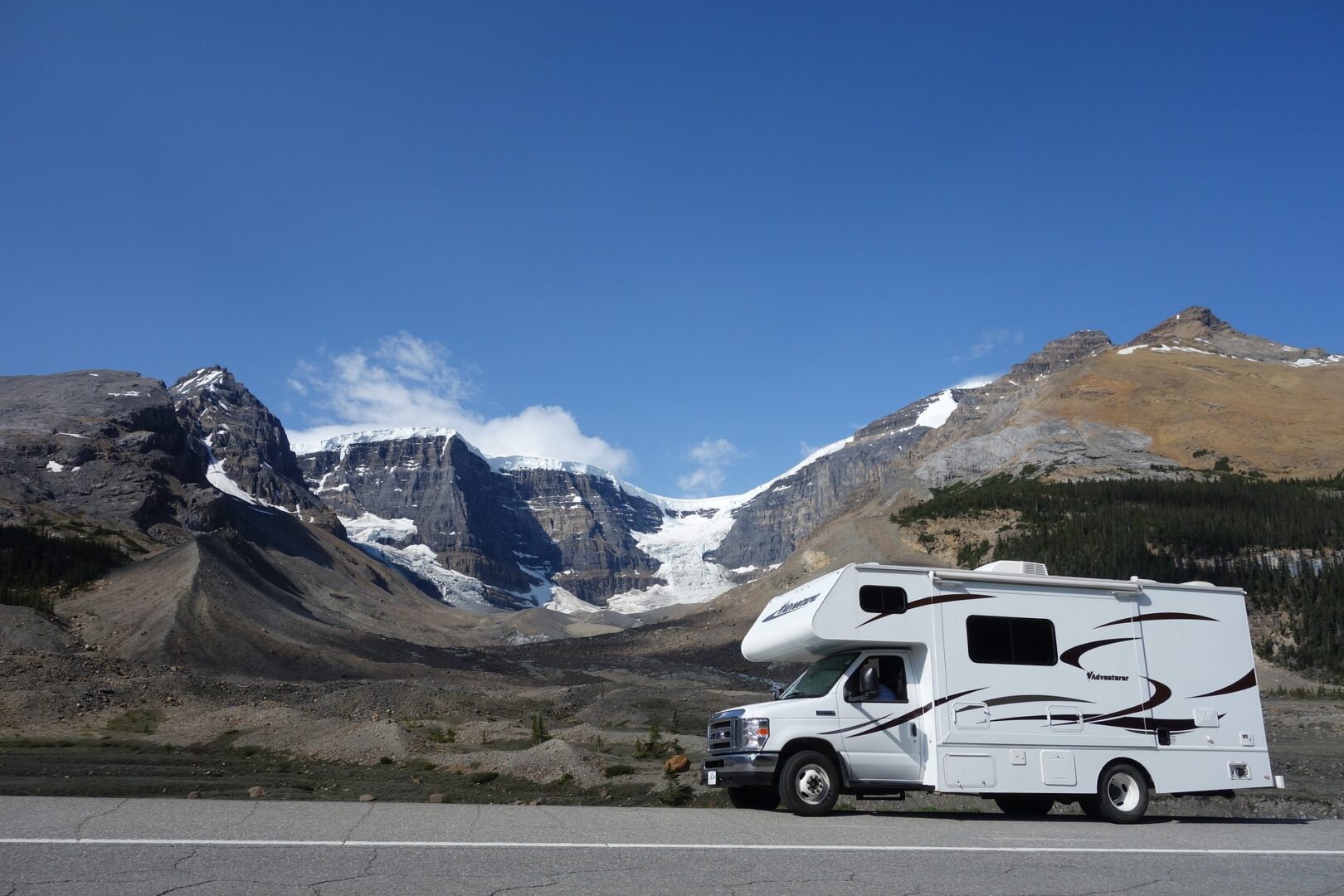
Be Aware of Your RV’s Measurements
We mentioned before that some routes are more challenging or even impossible for RVs to use. Most of the time the reason RVs can’t take these routes is because of size. For this reason, you will want to know the size and weight of your RV before you begin RV operation, so you know whether a route will work for you.
Low Clearances
Low-clearance bridges and tunnels exist all over the country. Your RV GPS should navigate you around these. That said, it doesn’t hurt to know how tall your RV is. That way, if you come across a bridge with a lower height, you know whether or not you’ll fit.
Bridge Weight Limits
Many small bridges have weight limits. Before driving over a bridge with a posted limit, think about the weight of your RV (plus everything you’ve loaded into it) to be sure it’s safe to cross. You might be surprised just how heavy an RV can be.
Narrow Roads
Generally speaking, interstates are plenty wide enough for any RV. That said, there are some smaller roads that do get quite narrow. Most of these will have a posted width limit. Therefore, knowing the width of your RV before you start driving is always a good idea.
Small Campsites
Finally, there is campsite size to consider. Knowing the length and width of your RV (with slides out!) will help you determine what size site you need when choosing a campground.
Know Your Hookups and Tanks
Now that you have an idea of how to get from point A to point B, let’s talk about the next step of RV operation: setting up camp. Obviously, you will need to unhitch if you’re pulling a trailer or a tow car, and you should level the rig using leveling blocks under the tires. Some RVs will also require that you put down stabilizer jacks.
The next step? Hookups and tanks.
Start with Electric
First, it’s important that you know what amperage your RV requires. Most smaller RVs require a 30-amp hookup. Meanwhile, big rigs will need 50-amp. Knowing this when choosing your site will ensure you have the type of hookup you need.
If you end up on a campsite with only one amperage but you need the other, you can always invest in an adapter. Just know that when plugging a 50-amp RV into a 30-amp outlet, you will need to carefully watch how much electricity you use at any given time.
To plug into the electric box, simply ensure the breaker to the outlet you wish to use is flipped to ‘Off’, then plug your RV’s power cord into a surge protector, which in turn plugs into the socket. Flip the breaker back on and you should have power.
When it comes time to unplug, flip the breaker back off, pull the surge protector from the socket, and put the surge protector and power cord away.
Hook Up Water
Once you have your electric hookup sorted, it’s time to turn your attention to the water. Most campsites have a water spigot. Connect your water pressure regulator to the end of a freshwater (white) hose and connect the pressure regulator to the spigot. Connect the other end of the white hose to the city water connection port on your trailer or motorhome. Turn the water on slowly and adjust as needed.
If your site doesn’t have a spigot, you will need to fill the freshwater tank before you park. To do this, locate the freshwater fill label on the outside of your RV (sometimes labeled as “city water” or similar). Remove the cap, connect a freshwater hose to a potable water spigot, place the other end of the hose inside the freshwater fill (or connect it if necessary), turn the water on, and fill it until the control panel indicates that the tank is full.
This water will be accessible from your sink(s), shower, and/or toilet once you’ve turned on your RV’s built-in water pump.
Learn How to Dump Your Tanks
Lastly, you will need to know how to dump your tanks. First, be sure to don some disposable gloves.
Connect your sewer hose to the dump pipe on the outside of your RV by twisting it on. Using an adapter piece, connect the other end of the sewer hose to the sewer drain pipe on your site or at a dump station, making sure it is twisted in securely.
When your tanks are full enough to dump, open your black water tank valve first, allowing everything to drain from the tank. This may take a while, depending on how full it is. When it stops trickling, close the black tank valve and open the gray tank valve, ensuring it empties completely by listening for the water to stop draining. Close the gray tank.
After emptying your tanks, it’s a good idea to put a few gallons of water down the toilet and one of the sinks, along with some tank cleaner to keep things fresh.
Tackle that Mountain! How to Prepare for Difficult Driving in an RV
I will never forget that first mountain pass we drove over in our 42-foot RV. It was terrifying. Not only were we 42 feet long, but we were also towing a motorcycle and a car. I was not prepared for the white-knuckle road ahead.
Yes, it’s true that RVs are great for taking you to new places where you can enjoy some pretty awesome surroundings, but it’s important to be prepared to occasionally cross difficult terrain.
When you’re just starting out with RVing, you should consider practicing mountain conditions prior to facing them. There are things to know and ways to practice before you leave on vacation to make sure you are ready to face any challenge ahead.
How about a quick game of true or false to test your mountain driving knowledge.
True or False?
You’re going up a steep incline. Make sure you have enough power to make it up by stepping on it and gunning the engine.
FALSE! Don’t Gun The Engine!
Many newbies think gunning the engine will help push their RV up those tough hills. WRONG. Take your foot off the accelerator. By gunning the engine you put extra stress on your engine which in turn could cause a serious breakdown. This is not like in the movies. You are not racing up the hill.
Instead, find your RV’s optimal power band and stay there. The power band is the range of RPM’s which your RV has the most horsepower for the road ahead of you. It could be 2,000 or 4,000 RPM. Most people try to activate this power band prior to climbing the hill. If you stay within the power band you will limit the stress on the engine, and you will climb the mountain safely. Climbing a mountain can be difficult driving. It’s important to be prepared.
This takes practice. You have to know where the sweet spot is and how to get there before you head out on a trip with difficult terrain. My suggestion? Locate a steep hill or long driveway in your city or town. Choose a time when there is a minimal amount of traffic and take the time to practice. Locate the spot where the engine stops chugging and becomes slow and smooth. This is the sweet spot. Soon you will locate this spot with no practice at all.
True or False?
You come to a steep downhill section of the road. You don’t worry because going downhill is easy as long as you pump the brakes as you descend.
FALSE. Don’t be a fool! Driving downhill in an RV is dangerous and can be more challenging than driving uphill.
You do not want to lay on the brakes. Brake replacement is expensive and crawling down a hill, pumping the brakes will cause extreme stress. If you go fast you could lose control. The best plan is to travel at a steady, slower speed. Going downhill can be difficult driving. Take your time.
If your rig has a manual transmission, avoid using the brakes when possible. Simply shift to a lower gear at the top of the hill. Traveling in second or even first gear will provide resistance as you cruise down the hill. Pump your brakes on occasion, but not continually.
If you have an automatic transmission the engine will do most of the down-shifting for you. Again, light pressure on the brakes will help control your momentum. Do not ride the brakes or you will cause excessive wear.
To gain confidence practice going downhill in your rig prior to travel. Remember to adjust your speed, tap your brakes, and downshift as needed. The more you practice in your RV the more confident you will feel.
Safety should always come first. Don’t wait till the moment of crisis. Gain confidence before your vacation so that you can handle the steepest hills and the deepest valleys. You’ll be glad you did!
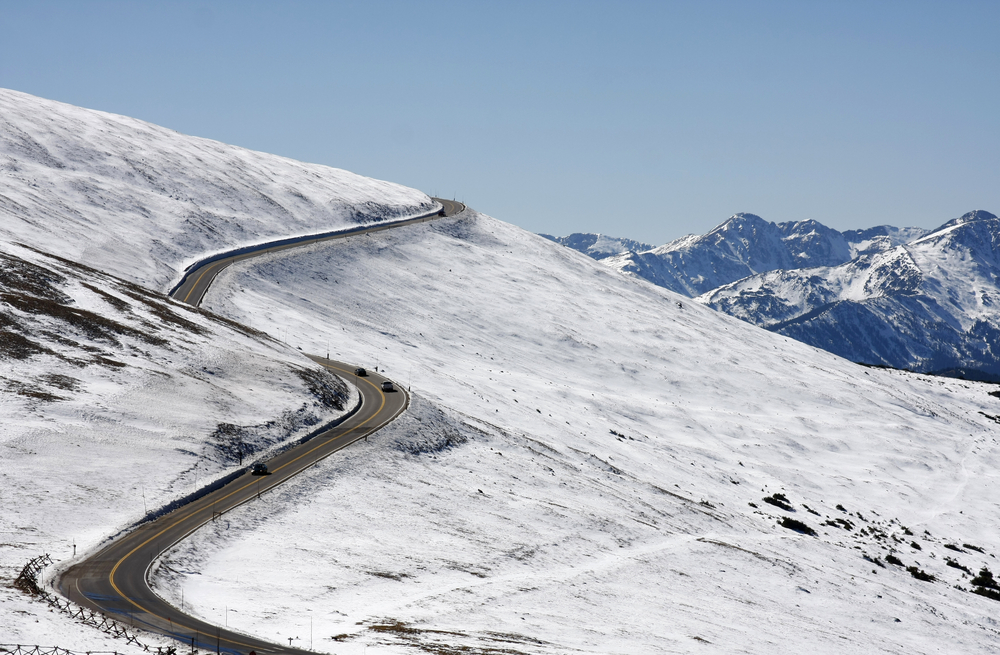
How to Drive an RV in Winter Weather
If you’re planning to drive your RV through a wintery landscape soon, you may be facing a level of fear — even if you took to RV driving like a pro in the first place. Icy roads and snow-covered shoulders add a whole new level of hazard to driving any vehicle, let alone one big enough to hold an entire house.
But if you follow a few best practices and make sure to prepare as much as possible, motoring your way through winter wonderland will be a piece of cake. (OK, maybe that’s overstating it a bit. But it won’t be so bad, and it will be crazy beautiful. And you’ll have access to all the gear to make fresh hot chocolate the moment you reach your destination!)
So before you set out into the frozen tundra, here’s what you need to know.
1. Your RV handles differently than your car.
Handling an RV is a totally different animal.
Most motorhomes utilize rear-wheel drive, as opposed to the front-wheel drive common in most smaller passenger vehicles — which means that many of the tactics you’d use to divert a slippery situation in your car won’t work the same way in your rig.
Although the sheer weight of the RV might make it feel as if you’re steady on the ground, most of that mass is in the front wheels. And in a rear-wheel drive vehicle, that means you have less control and traction. Even if you’re towing, keep in mind that you’ve got a lot of weight behind you, and if you brake too late or too hard, that weight will push your vehicle around — to say nothing of the risk of jack-knifing, should the trailer skid.
So, what can you do? Go slowly, brake easily, and leave tons of room between you and the car ahead of you.
Additionally, double-check the manual of any automatic brakes or brake controllers you might have equipped to ensure they’re meant for operation in snowy conditions.
2. Check your tires.
Even if you routinely skip the snow tires on your day-to-day vehicle, you’ll want to spring for an upgrade in your RV. Most rigs come pre-equipped with highway tread or summer tires, which are quiet — but lack the gripping power you need to stay safe in the snow.
You’ll also want to pick up a set of tire chains in case conditions get seriously messy. In fact, some states require chains by law during adverse conditions, especially for trailers. Be sure you know the rules in the areas you’ll be visiting before you hit the road.
3. Use your low beams.
Ever walk through a snowy landscape without sunglasses? Bet you didn’t make that mistake twice.
Bright lights reflect off snow, disrupting your vision. Use your low beams if necessary, and if possible, avoid night driving altogether. The snow itself is enough to deal with — you don’t need to add darkness to the mix!
4. Your RV’s pipes can freeze, too.
You take precautions to winterize your home, right?. RVs need to be winterized too. Otherwise, you may be facing a costly repair bill and a huge inconvenience when your rig’s pipes freeze halfway through your trip.
Although some RVs do have heated water duct systems, many do not, especially if yours is an older model. If you’re not sure, check with your local motorhome specialist to see what steps you need to take. Aside from wrapping pipes in heat tape, you can also find RV-specific antifreeze for potable water systems. Be sure not to use the regular automotive kind! If you’re boondocking, you can keep a pencil thin stream of water running to help.
5. Check your batteries.
Cold weather decreases battery performance, and you don’t want to end up stalled out or without access to heat.
Ensure all your batteries — including auxiliaries — are well-charged and in good working condition before leaving. And just in case, make sure you’re well-stocked on propane, too: You may need to run your generator for heat.
6. Gear up.
Ensure you’ve got plenty of bottled water, extra food, blankets, and lots of clothing. You’re better off safe than sorry if you should find yourself stuck.
Psst: Don’t forget your windshield ice scraper!
7. Don’t be afraid to change your plans.
Bottom line? If you’re feeling unsure or unsafe, stop.
Derailing your travel plans might be a bummer, but it’s a whole lot better than sliding off the road into an icy ditch, or worse.
Take advantage of the opportunity to gas up, and maybe even to explore a town that wasn’t originally on the docket. Your final destination will still be there when the weather clears up.
Always check the weather for rain and snow before your trip, as both of these things can make driving a big rig much more dangerous (especially if you’re inexperienced). If you do see that inclement weather is on the radar, consider rescheduling your trip or leaving a bit earlier to avoid the storm.
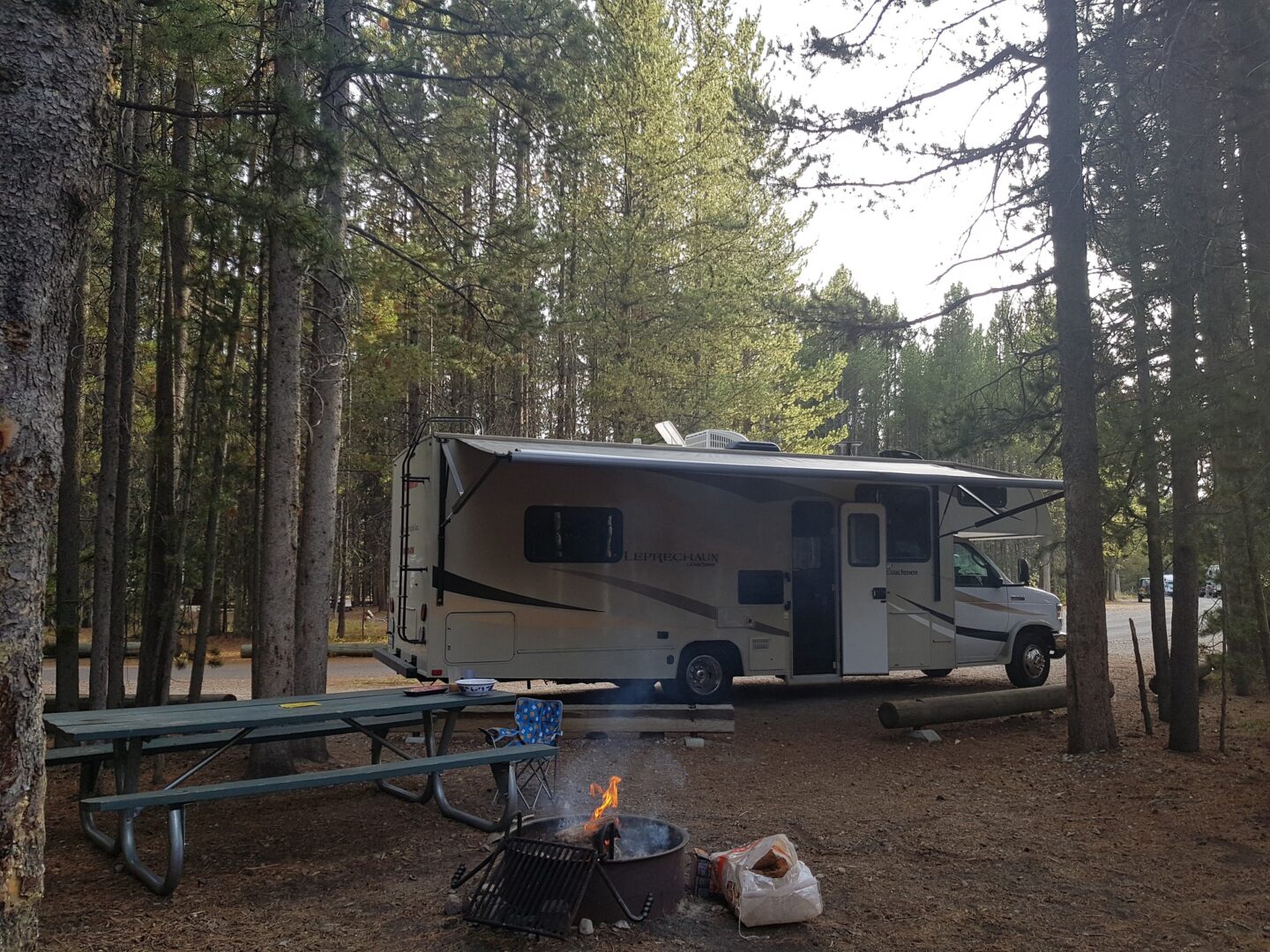
How to Plan Your Trip
You now know the basics of how to start RVing. The next step is to plan your trip. In our opinion, this is one of the most fun parts, so be sure to enjoy this process.
1. Find an RV
First, you will need to get access to an RV. This is easy enough if you own a motorhome of your own, but if this isn’t the case, you will want to look into renting one. Fortunately, RVShare offers plenty of options when it comes to rental RVs, so finding the perfect rig for your next adventure is only a few clicks away!
2. Plan a Test Drive
It’s very common for new RVers to rent a rig without scheduling in any “getting acclimated” time. They think they’re simply going to slip behind the wheel of this great, big thing they’ve never driven before and set off toward their destination, no problem.
This, of course, can be disastrous, leading to failed itineraries, broken plans, and worst of all, a negative camping experience that could keep them from coming back and discovering exactly how awesome this travel lifestyle can be.
If at all possible, make your first RV driving experience a short, slow, low-stakes one. Rent a rig for a quick weekend “staycation” at a nearby State Park, or even in your own backyard. You’ll be a lot less stressed getting accustomed to driving a large vehicle if you aren’t trying to do so on top of meeting pre-arranged reservations for your dream trip, and if you decide you hate it, you won’t have to face a long journey back.
If that’s not possible, then at least build a day or so of slow travel into your schedule so you’ll be able to take the time you need to be truly comfortable before you’re speeding around.
3. Plan Short Drives
When planning your adventure, keep in mind that you’ll be driving slower than usual. On top of that, fuel stops can take much longer in a large vehicle such as an RV. For this reason, a trip that should take 5 or 6 hours according to the GPS can easily take all day. Take this into account when planning your travel days, and stick to shorter drives whenever possible.
4. Pay Attention to the Weather
Before your trip, check the weather report. Make sure there is no rain or snow in the forecast, as both of these things can make driving a big rig much more dangerous. If you do see that inclement weather is rolling in, consider rescheduling your trip or leaving a bit earlier to avoid the storm.
5. Map Out Fuel Stops
Speaking of fuel stops, it’s a good idea to map those out in advance. This ensures you never run too low on fuel, and if you do enough research, you can even make sure the stations you choose are big enough to easily pull into and back out of. GasBuddy is a handy app for scouting out fuel stations.
6. Book Campgrounds in Advance
Driving all day only to discover that the campground you’d planned to sleep in is full is a real bummer. For this reason, we highly recommend booking all of your campgrounds in advance, especially on your first few trips.
7. Choose Campsites Carefully
When booking those campsites in advance, make sure you know what kinds of hookups you’re looking for, as not all campsites include all hookups. Additionally, you may want to request pull-through sites at first until you get some practice with backing your RV up.
8. Use RV Trip Wizard
One of our best planning tips is to use an RV trip planning app. We really love RVlife Trip Wizard, as we find it covers all bases, as well as the Roadtrippers app for easy planning.
9. Keep a Checklist
This is a lot to remember about RV operation, and you’re sure to come across other little things you’d like to keep in mind for next time. For this reason, we highly recommend keeping a running checklist of all the things you need to pack, as well as the steps you need to take when setting up camp and when breaking it back down.
This will help ensure everything gets done correctly and goes smoothly so you can fully enjoy your RV vacation.
5 Common Misconceptions About Driving Rental RVs
Whether you’re toying with the idea of renting an RV or you’re just curious to learn more about this type of travel, there are a whole lot of misconceptions out there about rental RVs. That’s especially true when it comes to RV rentals by owner — for those of us used to dealing with large, commercial rental dealerships, it can feel a little confusing to go down the peer-to-peer route at first.
But we’re here to show you that renting an RV through RVshare doesn’t have to seem strange! On the contrary, in fact: not only does RVshare help you find cheap RV and camper rentals, but it can also lead to lasting friendships and even make you fall deeply enough in love with RVing to buy a rig of your own.
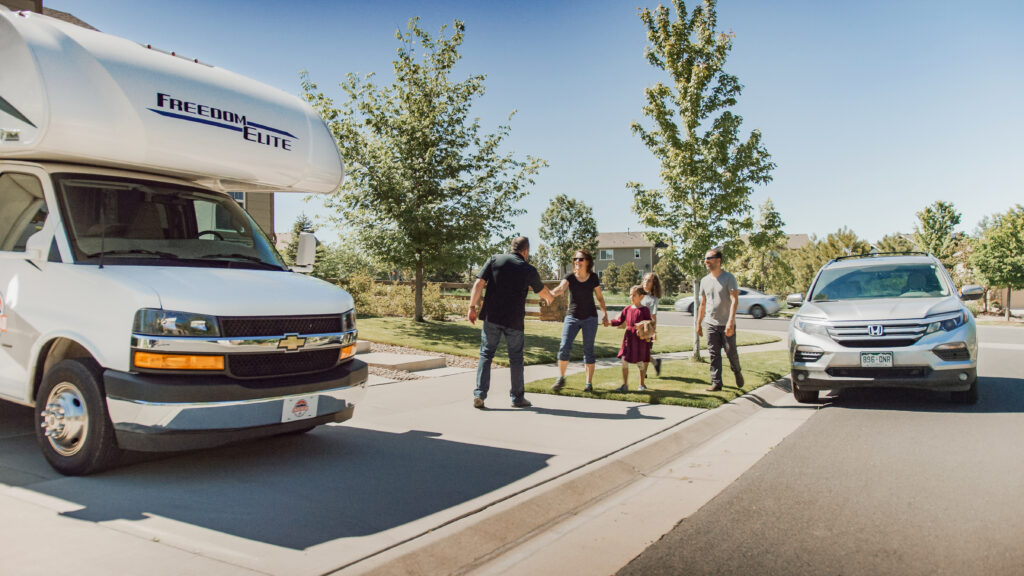
1. Driving campers is crazy difficult.
Even the boldest driver can be a little nervous when it comes to driving a vehicle that’s more than twice the size of your day-to-day car. But most RVs are actually surprisingly simple to drive — in fact, it can even be fun once you get used to it!
Think about it this way: driving an RV doesn’t require a special license, so how much different from regular driving can it be? Class B RVs, for instance, are built into traditional truck chassis, so it feels almost exactly the same as driving a pickup truck.
Of course, as in any driving situation, it’s always important to take your time, brake early, and double check your blind spots. Just like any other new vehicle, driving an RV comes with a slight learning curve… but you’ll be a pro in no time.
2. Rental RVs aren’t worth the cost since you have to do the work to drive them.
Psst: want to know a secret?
If you really don’t want to drive an RV, there are lots of RVshare rental owners who will drive it for you! Of course, we’re not saying they’ll let you hire them on as your personal chauffeur (although we guess it couldn’t hurt to ask). But if you have a specific destination in mind, many RVshare owners offer to deliver and set up the rig at your campsite for you.
3. Finding rental RVs by owner near me is difficult and unreliable.
You may think that renting through a peer-to-peer RV rental marketplace like RVshare is unreliable or complicated, or maybe you’re concerned that once you spend your money, the RV’s owner will leave you hanging.
But nothing could be further from the truth. RVshare makes the whole process simple and safe, taking care of all the rental logistics so all you have to do is sit back and enjoy your vacation.
For example, each of our RV rentals comes with a comprehensive insurance coverage plan, as well as 24/7 roadside assistance just in case something does go wrong on the road. The listings also feature user reviews to help you know what to expect from the vehicle and its owners. It’s all just about as clear and straightforward as possible!
4. Instant rental RVs do not exist.
Maybe you’re attracted to the idea of walking onto a commercial rental dealership lot in the morning and walking away that afternoon with the keys. It seems like working out a deal one-on-one with a private RV owner could be a much longer, more drawn-out process.
But if you’re looking for fast RV rentals, RVshare is arguably a better choice than your local big-box rental chain. We have many listings featuring instant RV rental bookings — just look for the lightning-bolt symbol. We challenge you to find a commercial dealership that can act that fast!
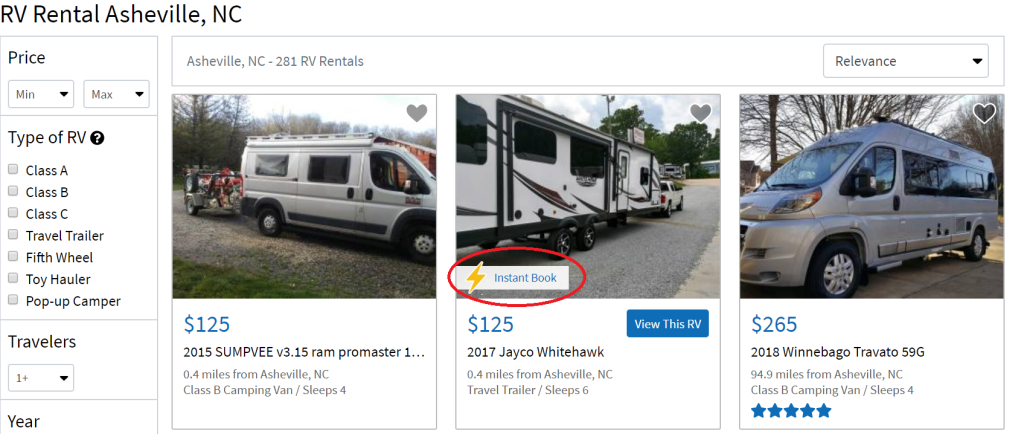
5. Cleaning RV holding tanks is a certified nightmare.
For many would-be RV renters, this is the one problem they simply can’t get past. The convenience of traveling with a bathroom does mean you may have to clean your RV rental’s waste tank… which can sound like a nightmare if you’ve never done it before.
But in truth, emptying an RV’s waste tank is just about as simple as turning on a faucet, and possibly even cleaner (especially if the faucet in question is one in a public restroom). RV sewer hoses are opaque and sturdy, so you won’t see, smell, or deal with any of the waste material up close and personal. The whole thing takes less than ten minutes!
RVshare really is one of the easiest and most effective ways to find an RV rental unit, no matter where in the USA you’re starting from or headed to. Our owners offer unique and comfortable RV listings in every state in the country, and all the information you need is right there on the front page — no need to worry about any last-minute fees or surprises.
In fact, many RVshare renters end up falling head over heels for this unique travel style, ultimately purchasing their own vehicles… and possibly even renting them out on RVshare. Full circle!
For more details on the RVing lifestyle, we recommend the following books, which are available affordably on Amazon:
- A Beginner’s Guide to Living in an RV: Everything I Wish I Knew Before Full-Time RVing Across America by Alyssa Padgett
- RV Living: An Essential Guide to Full-time Rving and Motorhome Living by Matt Jones
- The Idiot’s Guide to RVing by April Maher and Brent Peterson
- RV Hacks: 400+ Ways to Make Life on the Road Easier, Safer, and More Fun!
We’ve also written lots of great content about living that #rvlife right here on the RVshare blog. Here are a few of our favorite posts to get you started:
- Dipping a Toe Into the RV Lifestyle: Pop Up Campers, Small Travel Trailers, and Rentals
- Be Prepared! 7 Tips for Safe RVing
- 7 Helpful Hacks for RV Newbies
RVing is such a fun and special way to travel, and we hope this post has helped quell any fears that may be keeping you from getting started on your journey. Chances are, once you take the leap and secure your first RV rental, your only regret will be that you didn’t do so sooner.
Happy camping new RVers! You got this!
This post contains affiliate links. RVshare may receive compensation if you make a purchase after clicking on a product or service link.

